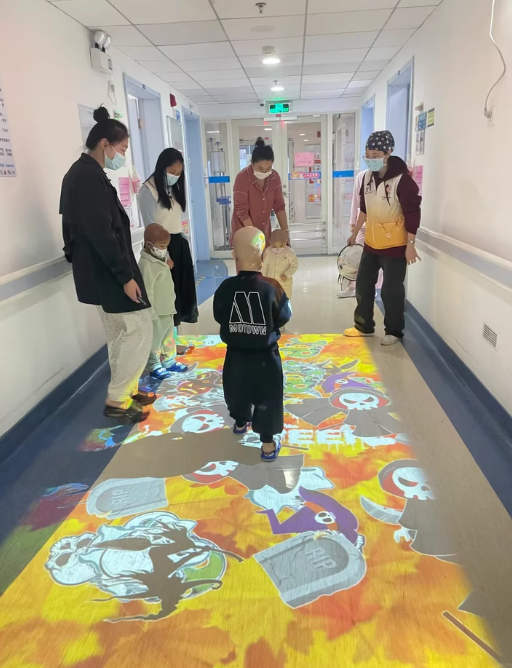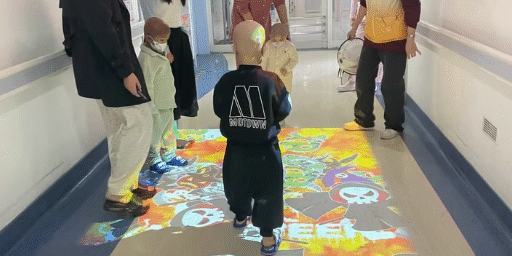Introduction: When Technology Meets Therapy
Rehabilitation is no longer confined to repetitive exercises in clinical environments. With the integration of LiDAR (Light Detection and Ranging) and interactive projection technologies, a new era of intelligent and engaging recovery is emerging. These systems allow rehabilitation patients to follow projected exercises while their movements are tracked and analyzed in real time—without the need for any wearable devices.
This article explores how LiDAR interactive projection training systems work, their benefits, and why they are rapidly being adopted in hospitals, senior care centers, and rehabilitation clinics.

What Is LiDAR Interactive Projection Training?
LiDAR interactive projection training is a smart, contactless rehabilitation system that combines visual guidance with 3D motion tracking. Using projected animations and real-time LiDAR motion capture, these systems guide rehabilitation patients through exercise routines while analyzing performance and providing instant feedback.
This method offers a highly immersive and adaptive training experience, enhancing both patient motivation and rehabilitation outcomes.
How It Works
Interactive Projection of Exercises
The system begins by projecting standardized rehabilitation exercises—such as balance, coordination, or limb movement drills—onto a wall or floor. These exercises are shown using animations or videos, accompanied by clear audio instructions.
Rehabilitation patients can easily follow and mimic the demonstrated actions, making it easier for them to engage both physically and cognitively in the training process.
Real-Time Motion Tracking with LiDAR
As patients perform the exercises, a LiDAR sensor continuously scans the training area, capturing the full-body movements of each participant in 3D space.
This real-time motion capture allows for:
- Accurate tracking of limb positions, posture, and movement patterns
- Non-contact operation—no sensors or wearables required
- High precision even in varied lighting conditions
The result is a natural and unrestricted movement environment that respects the physical limitations and safety needs of rehabilitation patients.
Instant Feedback and Performance Analysis
Once the system captures motion data, it is sent to a central processor where it is analyzed and compared with the standard movements programmed into the system.
The system evaluates:
- Completion accuracy of each exercise
- Movement fluency and timing
- Deviation from correct postures
If the system detects any errors, it provides instant corrective feedback through visual cues or voice prompts, enabling patients to immediately adjust their performance without therapist intervention.
Diverse and Customizable Training Content
Every rehabilitation journey is different. That’s why these systems support customized training programs that can be adapted to individual goals, physical conditions, and recovery phases.
Whether for post-surgical recovery, elderly mobility training, or pediatric motor skill development, the system can adjust its difficulty and focus in real time, offering a truly personalized rehabilitation experience.
Comprehensive Progress Reports
At the end of each session, the system generates a detailed evaluation report, which includes:
- Percentage of correctly completed movements
- Overall training scores
- Improvement trends over time
These reports help both rehabilitation patients and therapists track progress, identify weaknesses, and plan future training with greater precision.
Why Choose LiDAR in Rehabilitation?
Enhances Patient Engagement
Traditional rehabilitation exercises can become monotonous. Interactive projection and real-time motion tracking make the process more stimulating, encouraging rehabilitation patients to actively participate and remain motivated.
Reduces Therapist Workload
By offering automatic tracking and feedback, the system reduces the need for constant hands-on supervision. Therapists can efficiently manage multiple patients while ensuring each one receives targeted guidance.
Safe and Contactless
No physical sensors are required. This is particularly beneficial for rehabilitation patients who have sensitive skin, are immunocompromised, or are recovering from surgery. The system supports hygiene and safety standards without sacrificing functionality.
Personalized for Every Patient
The flexibility of the system allows therapists to design specialized programs for various rehabilitation needs, including:
- Postoperative recovery
- Neurological rehabilitation
- Early intervention for children
- Elderly fall prevention and balance training
Common Applications
LiDAR interactive projection systems are currently used in:
- Hospital rehabilitation and physical therapy departments
- Community-based rehabilitation centers
- Early childhood development and special education institutions
- Elderly care facilities and nursing homes
- Smart public fitness spaces and health parks
These systems are not only helping rehabilitation patients recover more effectively but also enabling medical and wellness professionals to offer technology-assisted therapy at scale.
Looking Ahead
As artificial intelligence and movement analysis algorithms continue to advance, we can expect even more intelligent and adaptive rehabilitation systems. These future solutions will be able to detect subtle improvements, adjust training dynamically, and deliver data-driven insights that accelerate recovery.
LiDAR is the foundation of this smart rehabilitation future, transforming recovery into a more efficient, personalized, and empowering experience.
Call to Action
CPJROBOT specializes in the research, development, and manufacturing of POE interactive LiDAR and industrial radar solutions. We provide tailored technology for smart rehabilitation systems, interactive training platforms, and real-time motion tracking applications.
If you are designing an intelligent rehabilitation center, smart fitness park, or personalized therapy platform, we’re here to help.
Contact CPJROBOT today to discuss your customized LiDAR solution for rehabilitation and beyond.







